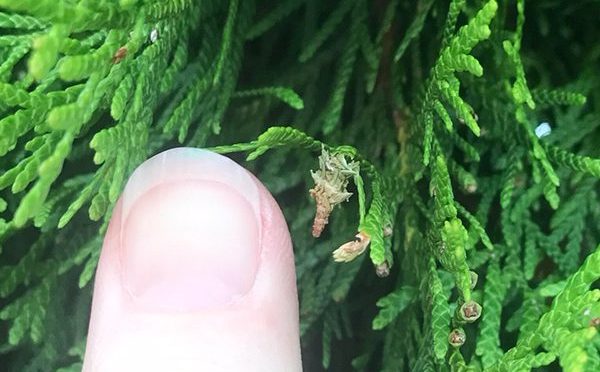Bagworms are about as beneficial as they are cute—which, if you saw the header image of this article, is not at all. These creatures latch onto trees and shrubs, which can cause irreversible damage to evergreens and even death. They’re also pesky for lawn care professionals to get rid of once they’ve popped up, but they can be treated preventively! We’ll briefly cover what bagworms are and why they’re a nuisance before hopping into how to treat for them.
What Are Bagworms?
Bagworms are the larval (caterpillar) forms of a family of moths, known as Psychidae. These invasive insects are named for the silk and foliage-laden bags they form around themselves. Unlike many other types of insects, bagworm moths spread slowly, but the damage they can cause should not be underestimated.
Bagworms move around for sustenance, carrying their bags with them as they crawl from plant to plant and tree to tree. They feed for several months before molting (you’ll want to treat them chemically before they do this) and emerge as moths—the males, that is. While the males emerge from their pupal stage with wings, the majority of species’ females remain inside their bags for the entirety of their lifecycle, never sprouting wings. The reproduction process takes place in the females’ bags, where they lay several hundred to 1,000 eggs. Those hatchlings will be next year’s problem, which is why eliminating bagworms is so important.
Issues Bagworms Cause
Defoliating insects like bagworms are among a lawn care professional’s worst nightmares. Not only do they chew through leaves and affect aesthetics, but they can also permanently damage—and sometimes kill—what they feed on, especially evergreens. Plus, bagworms use their silk-spinning abilities to spread to other trees and shrubs, meaning that if one tree or shrub is at risk, they all are.
The more they feed, the larger the bag becomes. Bagworms start out small, though, and blend in. By the time many people notice that bagworms are present, major damage has likely already occurred, which is why treating them early is the best way to get rid of them.
What Bagworms Feed On
Bagworms feed on over 50 families of plants. Their entrees of choice include broadleaf and evergreen trees and shrubs:
- Juniper, pine, cedar, arborvitae, and spruce (Coniferous)
- Maple, locust, boxelder, and sycamore (Deciduous)
While deciduous trees will suffer minimal damage, conifers are in the “high risk” category when it comes to susceptibility, which is why protecting them before bagworms strike is vital. Bagworms will typically start feeding at the canopy and work their way down. This results in a browned, dead appearance in some places. Eventually, the tree or shrub can die, but it will look sad and unhealthy for quite a while before that happens.
That damage will be very noticeable, so taking care of bagworms before they hatch and reproduce is an important part of ensuring a healthy, aesthetically pleasing property for customers. We’ve harped on this point at the end of the last three paragraphs, not because we like repeating ourselves, but rather because it is the only way to ensure they don’t come back to ravage your landscape next year.

Treating Bagworms Preventively
Phenological indicators are a great way for lawn care professionals to determine when to make their pesticide applications. Phenology (not to be mistaken with phrenology, a pseudoscience) is the study of using biological changes in plants to determine when certain events will take place. In the context of bagworms, it involves using clues in nature as to when they will hatch. For instance, when Catalpa blooms, it falls around the same time that bagworms hatch.
Phenology can give lawn care professionals an edge on the bagworms, and while accurate, some may choose a more general approach. For those in that boat, treating them at the start of summer—near the end of May into early June—to treat the first instar larvae is the norm.
Whichever timing method you choose, pyrethroid products including bifenthrin, as well as carbaryl or Conserve (spinosad) will eliminate the bagworms before they’ve done extensive feeding.
Chemical applications will not be effective after they’ve gone into their pupal stage before emerging as an adult. Physically removing bagworms by hand is the only option at this point. After grabbing a ladder, if needed, some choose to cut bagworms down one by one with a bladed tool or shears. They then destroy the creatures by tossing them in a bucket of soapy water and dispose of them. Important note: You can’t toss the bagworms to the ground once you’ve snipped them from the plant or tree, because they’ll crawl right back up.
Chemical Products for Treating Bagworms
A broad-spectrum insecticide may seem like the best way to go, but it’s important to take into account that beneficial insects may be harmed, too.
Corteva’s Conserve SC is a softer option and will eliminate target insects while posing a minimal threat to beneficial insects. It also touts high activity at low use rates and no threat of phytotoxicity to ornamentals.
Bifenthrin products offer curative control where systemic options aren’t viable. As a contact insecticide, bagworms won’t stand a chance. If you’re anticipating bagworm problems this year, one of our reps can help you strategize on how to get rid of them before they become a problem.












